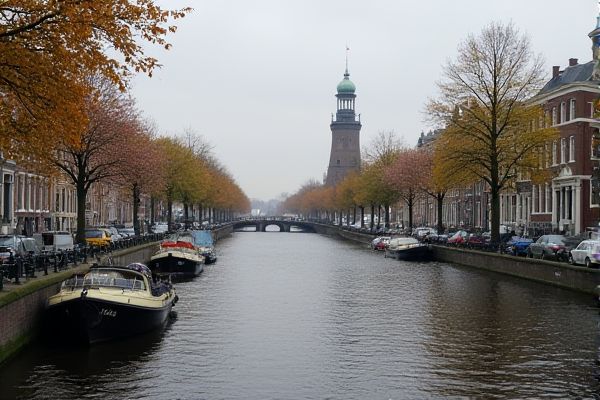
Transportation and commuting in Netherlands: Extensive cycling infrastructure. Reliable public transport system. OV-chipkaart for public transit. Well-connected train network. Regional bus services available. Trains are efficient and frequent. Cars less necessary in cities. Bicycle parking available everywhere. Car-sharing services accessible. Cycling is fastest in cities.
Extensive cycling infrastructure.
The Netherlands boasts an extensive cycling infrastructure, with over 35,000 km of cycle paths, including dedicated bicycle highways (fietssnelwegen) that connect cities and towns. These pathways prioritize cyclist safety and efficiency, integrating seamlessly with public transport to promote sustainable and healthy commuting. For more information about this incredible cycling culture, you can explore the detailed insights on Cycling In The Netherlands. This interconnected system not only encourages eco-friendly transportation but also supports a lifestyle centered around health and sustainability, making the Netherlands a global leader in cycling innovation.
Reliable public transport system.
The Netherlands boasts a highly reliable public transport system, with modern and comfortable trains, buses, trams, and metro lines that are efficient, sustainable, and well-connected. Despite some cancellations, trains are on time 92% of the time within five minutes, and the overall system is punctual and integrated, making it easy to navigate the country.
OV-chipkaart for public transit.
The OV-chipkaart is a contactless smart card and integrated ticketing system used for all public transport in the Netherlands. It is available in disposable, anonymous, and personal forms, each offering different features and benefits. These variations include top-up options, subscription capabilities, and security measures. For more detailed information about this system, you can visit the OV-chipkaart on its official page. This system has revolutionized the way passengers navigate public transport, ensuring convenience and efficiency across the country.
Well-connected train network.
The Netherlands boasts a dense and well-connected train network, expertly managed by ProRail, encompassing nearly all major towns and cities. With a total of 3,223 route kilometers, this network offers frequent services that include local Sprinter trains and faster InterCity trains. Most lines are electrified and come equipped with modern amenities such as Wi-Fi. For further information about this intricate rail system, you can visit the detailed page on Rail Transport in the Netherlands.
Regional bus services available.
Regional bus services in the Netherlands, particularly under the R-net initiative, offer reliable, frequent, and comfortable transportation. These services, operated by various carriers such as Connexxion, Arriva, and NS, provide efficient connections across the Randstad megalopolis, with buses running several times an hour and utilizing dedicated infrastructure for faster travel. For more details on these services, visit the official R-net website.
Trains are efficient and frequent.
Trains in the Netherlands are highly efficient and frequent, with the network operating over 2.2 million passenger services annually, and punctuality rates reaching 94.4% within a 5-minute margin on the main rail network. The system includes high-frequency services, such as the PHS programme, which enables 10-minute interval inter-city services on key corridors, and plans to further reduce intervals to 7.5 minutes. As the demand for rail transport continues to surge, ProRail is focusing on capacity and speed enhancements to meet the needs of its growing ridership.
Cars less necessary in cities.
In the Netherlands, cities are designed to make cars less necessary through extensive cycling infrastructure, such as cycle paths, protected intersections, and bike-only routes, which prioritize cyclists and pedestrians over motorized traffic, making cycling a safe and preferred mode of transportation. Additionally, urban planning strategies like the Unravelling of Modes ensure that cycle routes are separate and often more direct than car routes, further reducing the need for cars in urban areas.
Bicycle parking available everywhere.
In the Netherlands, bicycle parking is extensively available, with facilities like the temporary 800-space garage at 's-Hertogenbosch station and larger facilities such as the 12,500-bicycle capacity garage at Utrecht Train Station, highlighting the country's commitment to comprehensive bicycle infrastructure.
Car-sharing services accessible.
In the Netherlands, car-sharing services are widely available through companies like Greenwheels, MyWheels, ShareNow, and SIXTshare. These companies offer various models, including station-based and free-floating systems. With options for hourly or daily rentals and different subscription plans, they cater to diverse user needs. You can learn more about these services and their impact by visiting the DutchReview website, which provides insights into the shared mobility landscape in the Netherlands.
Cycling is fastest in cities.
Cycling is particularly fast and efficient in Dutch cities due to excellent cycling infrastructure, including cycle paths, protected intersections, and routes that are often shorter and more direct than car routes. This comprehensive network makes cycling a convenient and safe mode of transport. For more in-depth information on this topic, you can visit the detailed section on Cycling in the Netherlands to explore how these structures are implemented to enhance urban mobility.
